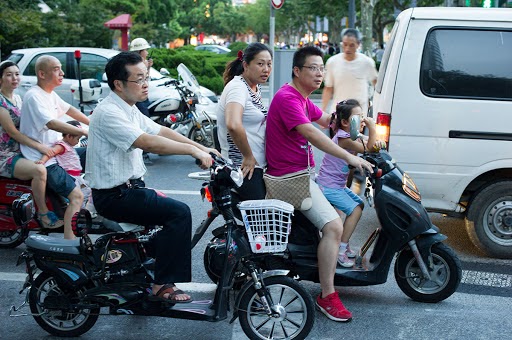With e-bike fatalities on the rise in China, experts call for mandatory helmet laws
Legal and public safety experts hope that mandating helmets for electric-bike riders can help reduce a grim death toll from skull fractures and brain injuries.

It’s a common sight across China: Multiple people balance precariously on a scooter, snaking through traffic and running red lights — all without protective headgear. Meanwhile, car drivers barely pay attention to anyone on two wheels.
In 2019, thousands of e-bike riders in China were sent to emergency rooms. According to a report (in Chinese) by the Chinese Ministry of Transport, 8,639 people were killed, and 44,677 were injured in traffic accidents involving e-bikes and scooters in 2019, which accounted for about 70% of all fatalities and casualties associated with two-wheel vehicles that year. The rate of scooter-related deaths and injuries almost doubled between 2009 and 2019.
The alarming numbers were cited heavily in a recent seminar at Peking University, where a group of experts and researchers urged the government to adopt a mandatory helmet law for e-bike and scooter riders.
“If we break down the numbers, basically every hour of every day, there was one death and five injuires related to scooters,” said Dèng Xiǎo 邓晓, a senior researcher at the Chinese Center for Disease Control and Prevention. She added that while brain injury was a major cause of death after all sorts of traffic accidents, the percentage of people who died from skull fractures was particularly high for scooter-related collisions. “Wearing a helmet can decrease the severity of a head injury as much as 80%. But most people don’t use helmets and don’t see them as an effective protection,” she said.
In China, e-bikes and scooters are an indispensable form of transportation. A study by the Chinese Ministry of Industry and Information Technology showed that as of June 2019, there were nearly 250 million electric scooters in China. Taking unregistered riders into account, the Global Times estimates “that number could be as high as 300 million.” Of that total, only 30% of drivers wear helmets.
In an effort to improve road safety, the Chinese Ministry of Public Security launched a campaign in May called “One Helmet, One Belt” (一带一路 yīdàiyīlù) — a word play on China’s multitrillion-dollar “One Belt, One Road” infrastructure project. The traffic initiative was intended to promote the use of protective headgear among scooter riders and toughen the enforcement of existing regulations that require motorcyclists to wear helmets and drivers to wear seat belts.
While the safety campaign did not make helmetless scooter riding a punishable offense, it created a buying frenzy. As Sixth Tone reported, the subsequent surge in helmet demand caused prices to double and even triple over the course of a few days. Opportunists were quick to jump on the bandwagon — more than 3,500 new helmet-related businesses were registered in the month after the initiative was announced.
But Deng and other law experts argued that more regulations were needed to prevent accidents involving e-bikes and scooters — primarily, making helmet-wearing a requirement for the rides. “When it comes to scooter management, there are a host of issues that can’t be addressed in a short period of time, such as common, risky behaviors like speeding. But if every driver can wear a helmet while on a scooter, it will significantly make the road safer for everyone,” said (in Chinese) Shī Lìdòng 施立栋, a law professor at Suzhou University.


